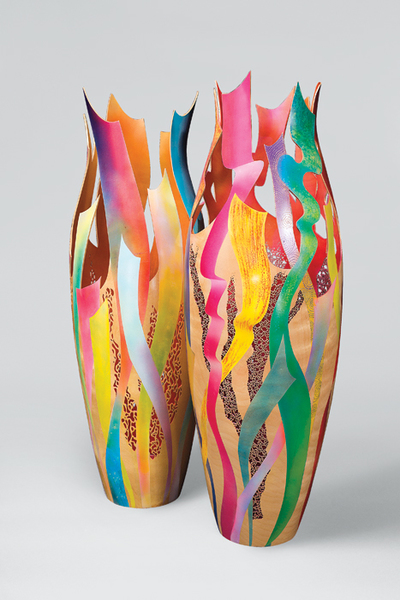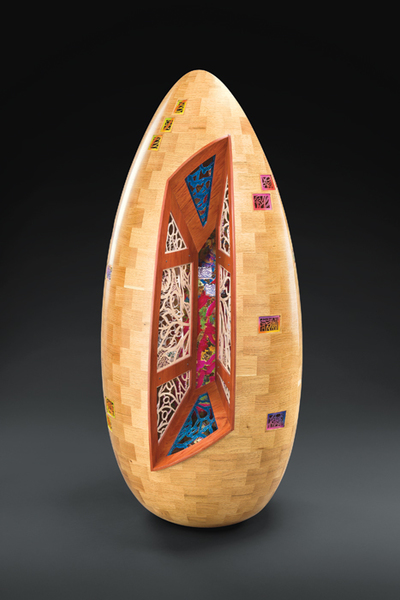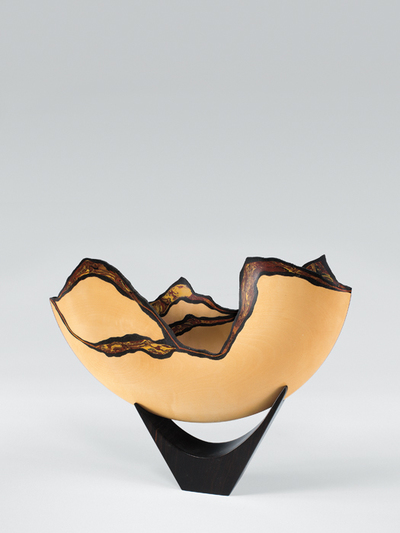Audacious: Reimagining Wood as Art
Frank Sudol, Giant Ribbons #2, 2002, birch, acrylic, paint, fabric paint, 46 x 14″; Giant Ribbons #1, 2002, birch, acrylic, paint, fabric paint, 44 x 14″. Photo: Terry Martin.
The exhibition featured at the Peabody Essex Museum (PEM) in Salem, MA, through June 21 is aptly titled Audacious: The Fine Art of Wood from the Montalto Bohlen Collection.
My dictionary defines audacious as “showing a willingness to take daring risks,” and this art certainly does just that. The creators have fashioned objects that are not only beautiful, but also inventive and exciting, with surprising state-of-the-art technical achievements. If that sounds like an announcement heralding the latest digital devices, it’s okay. Like new technology, most contemporary wood art did not exist a generation ago.
Wood is a natural material that attracts whittlers, carvers, painters and collagists. Artist Louise Nevelson used found objects to assemble massive wood sculptures. Craftspeople use the lathe to hollow out functional wood vessels.
Contemporary wood artists often begin with the lathe, a machine that shapes the wood by rotating it along its axis while pressing a fixed cutting tool against it. But ambition and audacity inspire some to venture beyond the tool’s limitations. They seek innovation. When they’re successful, the result, as the exhibition title notes, is “the fine art of wood.”
Frank Sudol, a pioneer in wood art, was challenged to see how thin he could cut wood. Working with birch, he created Ribbon Series (2002), tall urn-shaped vessels composed of colorfully patterned pastel strips of paper-thin wood ribbons that unfurl randomly at the vessel’s crown.
Top: Donald Derry, Of the Rainforest, 2006, Chinese elm, 19 x 18 x 21″. Photo: Terry Martin. Bottom: Curt Theobald with Binh Pho, Inner World, 2014, butternut, African padauk, birch plywood, acrylic paints, cast glass, 43 x 18 x 17″. Photo: Walter Silver/PEM.
Another pioneer among the international artists represented at PEM, David Ellsworth has devoted his 44-year career to perfecting and innovating vessel forms. In the exhibition catalog, he explains that he is “on a journey of discovery, where the hand and the eye, left on their own and devoid of the intrusion of the head, often produce some element of collective power….” He dares to trust instinct, skill and chance to determine the final work. One false move may destroy the art.
Among the more than 100 works on display, two vastly different objects reflect the range of Ellsworth’s talent. The round, quilted maple Vessel (1979), which looks like an elegant flying saucer, is so perfectly spare, the wood so smoothly finished, that it seems organic. It piques understanding how such a slim disk could be hollowed through such a small aperture on top. There’s no trace of the artist’s hand.
By contrast, the artist boldly decorated every surface of Intersphere, a piece from his 1991 “Solstice Series.” Ellsworth used a blowtorch to scorch the surface of an ash wood vessel for a burnt rippling appearance. A fissure in the shell, narrow at the base, wider at the rough rim, reveals the pattern inside. The artist painted the entire work with bright pigments, green on the interior, mostly pink, blue, yellow and ivory abstract forms on the exterior.
Both of Ellsworth’s works are included in the 47 gifts to PEM by Massachusetts collectors Bob and Lillian Montalto Bohlen. Altogether they have donated more than 800 pieces of contemporary wood art to museums and institutions in the United States and Canada, including the University of Michigan, Mobile Museum of Art, Addison Gallery of American Art and Princeton University.
Almost 20 years ago, the couple noticed that, although art museums regularly exhibited ceramics, fiber, glass and photography, wood was still regarded as a craft. They were determined to change that popular perception. Bob Montalto told PEM, “We decided we wanted to convince the art world that the best artists working in wood were artists—not craftspeople.”
They made a serious commitment to legitimize wood art. They became patrons, financially supporting artists for a year in order to provide them time to create. In return, the couple asked for first choice in the works artists made during that time. The exhibition is a testimony to
their vision.
Fraser Smith’s 2010 carved wood wall hanging, The Theory of Everything, is a show stopper. It is a colorful patchwork quilt draped over a horizontal cord. With silk dyes and mixed media on wood, the artist’s trompe l’oeil work renders the illusion of fabric. His meticulous details include representations of tiny stitches that appear to sew the pieces into patterns.
Marilyn Campbell, Igneous Series #3, Rare Elements, 1999, holly, pigmented epoxy, 9½ x 11 7/8 x 2″. Photo: Terry Martin. All images courtesy of the Montalto Bohlen Collection. © 2014 Peabody Essex Museum.
PEM’s one-room gallery exhibition hall is divided loosely into six sections, according to the complex forms and techniques artists used, yet there is overlap. Some artists, such as Stephen Hatcher, invented a technique that isn’t neatly categorized. For Island Caldera (2007), he fused calcite crystals in resin to a rim of maple burl. No one had ever managed to use the materials in that way. Ron Gerton developed equipment to turn and hollow vessels up to eight feet in diameter. Hugh McKay experimented with kilns to incorporate cast glass into his work.
Some artists tell stories with their art. Binh Pho shares narratives with delicately painted symbols. On Seven Poppies (2009), a vessel carved from box elder, he says, “The dragonfly represents the military helicopters of my childhood in Vietnam…the peacock feather represents the dream, poppies speak of mystery, and clouds represent change.” He adds that people familiar with his stories, “whether autobiographical or fictional…understand my works.”
Artists source many varieties of wood. Each species contributes its own characteristics to the finished art—different tones, colors and textures. Art lovers and conservationists can be assured, however, that the creators don’t fell endangered species. In fact, most of the wood the artists use is found, usually the result of storm damage or other natural causes.
Audacious is a breath of spring, witty and colorful. The handsome exhibition catalog illustrates each work with large, colorful images. It leaves no doubt that wood is a dynamic medium for artists.
Shirley Moskow, a former newspaper feature editor, writes on travel, arts and crafts, including jewelry and fiber, for national and international magazines.




